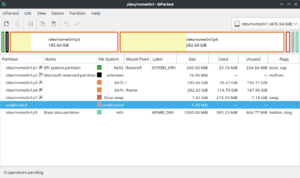GParted facts for kids
 |
|

GParted 1.3.1 showing a GPT-partitioned hard disk
|
|
| Developer(s) | GParted developers |
|---|---|
| Initial release | August 26, 2004 |
| Stable release | |
| Preview release |
Lua error in Module:Wd at line 1575: attempt to index field 'wikibase' (a nil value).
|
| Written in | C++ (gtkmm) |
| Operating system | Linux |
| Type | Partition editor |
| License | GPL-2.0-or-later |
GParted is a helpful computer program. It lets you manage the different sections, or partitions, on your computer's hard drive. Think of your hard drive as a big closet. GParted helps you organize the shelves inside it.
You can use GParted to create new sections, delete old ones, or change their size. It also lets you move or copy data between these sections. This is super useful if you want to install a new operating system like Linux. It also helps you organize your disk space better. You can even use it to prepare a USB stick.
How GParted Works
GParted uses special tools to understand and change your computer's storage. It can work with many different types of file systems. File systems are like the rules for how information is stored on a disk. Some common ones GParted supports include Ext4, FAT32, and NTFS.
This program is written in a computer language called C++. It has a simple, easy-to-use look, which is called a GUI. This makes it easier for you to see and click on what you want to do.
GParted Live System
The GParted team also offers a special version of GParted. It comes on its own small operating system. You can put this system on a CD or a USB drive. This lets you start your computer using GParted directly. It's useful for making changes to your main computer's hard drive. Many other Linux systems, like Ubuntu, also include GParted.
Copying with GParted
GParted can help you copy entire sections of your hard drive. This is like making an exact duplicate of a shelf in your closet. You can copy one section at a time. The section you want to copy should not be in use when you do this. GParted can copy a section to a new space, even if the new space is a different size. The only rule is that the original data must fit in the new space.
See also
 In Spanish: GParted para niños
In Spanish: GParted para niños
- Comparison of disk cloning software
- GNU Parted
- GNU GRUB
- KDE Partition Manager
- List of disk partitioning software
- Partition (computing)

